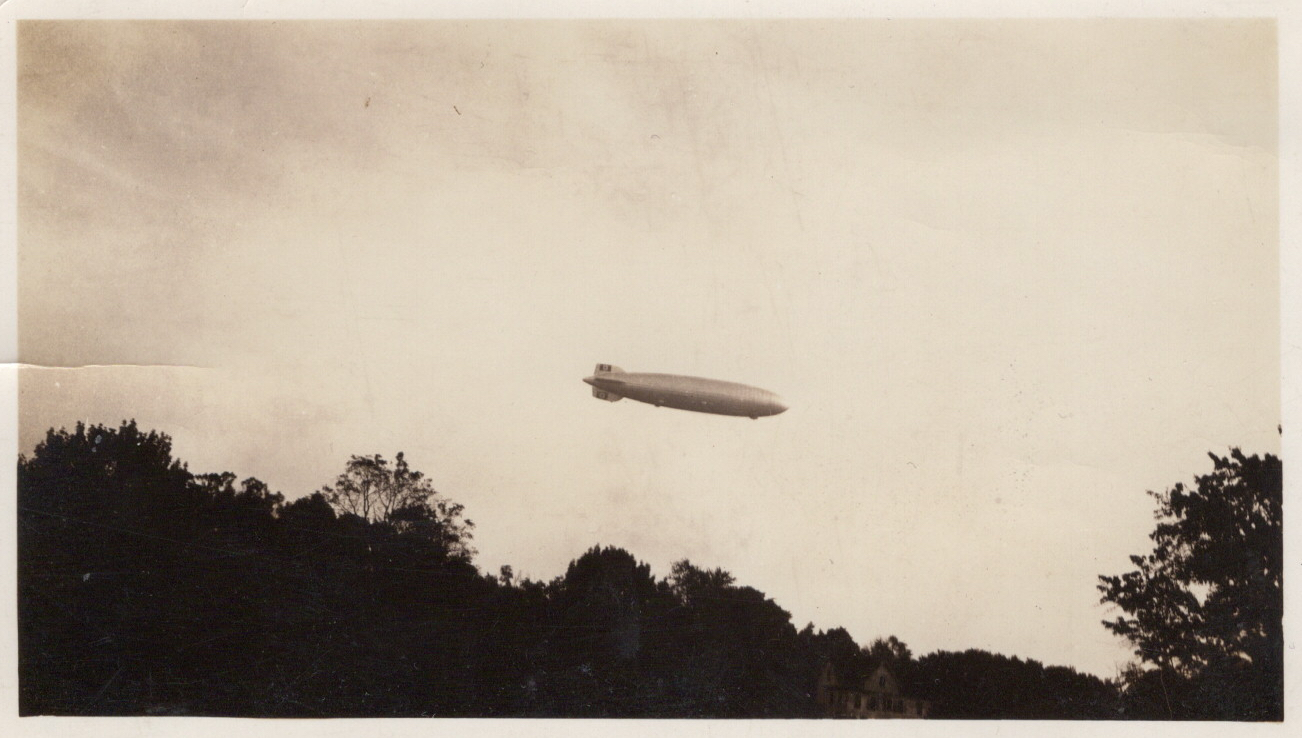|
Greetings one and all! What a beautiful Saturday morning we have today, full of sunshine, but with cool and dry air replacing the six days of high heat and humidity just passed. We are looking forward to a nice day Sunday for our Open House, which will be held from 1-5 p.m. Seats for the Victorian Luncheon filled quickly, and chef Joan Lundgren has been hard at work making this event possible. Thank you, Joan! Please note: today’s article is for historical purposes only. Some things stay with us our whole life, and sounds are one of those. Today I can still remember hearing, while playing in our yard, the sound of an approaching dirigible or blimp. A low drone could be heard for several minutes prior to seeing one of these airships. I would excitedly watch the sky and wait for it to appear overhead – a wonderful thing to see! I believe they were naval airships traveling from Weymouth, Ma. and for some reason they usually flew over my home on Foundry Street. Perhaps they were making their way to the Mansfield Airport, or perhaps going further towards the air base on Cape Cod. These lighter-than-air ships were a wonderful site to behold. There were Eastoners and others who, many years back, saw an even more stunning sight. My mother’s mother remembered seeing it as a child going over Easton, and my father’s father remembered seeing it over Brockton. What they saw was one of the most impressive airships ever – the Hindenburg. The Hindenburg was launched in Friedrichshafen, Germany in March of 1936. At more than 800 feet in length, and powered by four 1,100 horsepower motors, it was the largest rigid airship ever constructed. These zeppelins, as they were called, made transatlantic travel possible by air for commercial passengers. During that first year the Hindenburg carried 1002 passengers on 10 round trips between Germany and the United States. The trip could take up to three days each way depending on wind and weather, at speeds reaching 84 miles per hour. No crossings were made during the winter months due to often stormy weather conditions. Helium was the original gas to be used to “float” the Hindenburg. However, with a looming threat of war in Europe, the United States restricted any sale of that gas to another country that might use it to build airships for war purposes. That meant the use of hydrogen was necessary, and the Hindenburg was filled with 7 million cubic feet of that very flammable gas. In order to accommodate passengers in first class style, the Hindenburg featured two passenger decks. The “A” Deck, or the top deck, had a promenade and lounge on each side of the airship. Windows lined this deck, offering unprecedented scenic views for passengers. Aluminum was used extensively to save weight; the seats in the lounge were aluminum, and a baby grand piano for entertainment was built of aluminum as well. Covered in yellow pig skin, it only weighed 377 pounds! Passenger cabins were on the interior of this deck, between the lounges and promenade areas. In design they were similar to a sleeping room on a train car. To save weight, foam sheets were used to separate the cabins from each other. The “B” Deck below contained toilet facilities, a kitchen, crew quarters and a crew’s mess. There was one stunning amenity available on this deck for all to use. Believe it or not, a smoking lounge was installed! One had to enter the room through an airlock, and the room itself was specially insulated from the rest of the ship’s interior. Guests had access to a special lighter built into the room, the only one allowed on the ship, and could smoke freely day or night. After an uneventful first season, the Hindenburg's second transatlantic crossing of 1937 began in Germany on May 3. Following a flight path still used by commercial travel today, the Hindenburg turned north over the Atlantic, and at times would travel southerly over lower New England on its way to New York and New Jersey. On May 6 a strong storm and heavy winds delayed docking at Lakehurst, New Jersey until just after 7 p.m. In an event that has never been fully resolved, the great ship caught fire, and within a span of 30 seconds, disappeared from history. Thirty-five of the ninety-seven passengers and one member of the ground crew perished, and many of the other passengers were badly injured. The event was caught on film, and the disaster brought an end to the great age of lighter-than-air travel. On that fateful day in 1937, a young boy then living on Williams Street heard the unmistakable sound of an approaching airship. Robert Johnson ran home, grabbed a box camera, and made his way to the hill where the North Easton Grammar School stood. From that high vantage point, he took the photo below. Here is the Hindenburg, which had just passed over North Easton about 600 feet in the air. Mr. Johnson believes the great ship was very near the Brockton line when he snapped this image. No one could have imagined the disaster that would occur only a few hours later. Until next week, stay well,
Frank
0 Comments
Your comment will be posted after it is approved.
Leave a Reply. |
Author
Anne Wooster Drury Archives
June 2024
Categories |
Easton Historical Society and Museum
PO Box 3
80 Mechanic Street
North Easton, MA 02356
Tel: 508-238-7774
[email protected]

